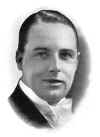| Bandleader Born: 1889, India Died: May 5th, 1928, London John W. Birmingham was from a military and musical family (his father was a bandsman in the Cameronians) and was a Kneller Hall man, graduating in about 1908. During the First World War he served with the Scottish Rifles and gave numerous concerts in aid of Belgian refugees. He is alleged to be able to play five instruments, including violin, banjo, piano and organ. John Birmingham has been described as a "pioneer of syncopation". For many years his bands fulfilled important dance and stage engagements and played for some years at the Hotel Cecil where his brother, Cyril, was the band's pianist. During the mid-1920s, his band, known as "The Big Twelve" recorded for Edison Bell Winner (1925) and Duophone (1926). The original records are hard to find today and none, as far as I know, have been reissued on LP or CD. The musicians who
played in his band in 1925 are: At some point later, Arthur Coburn replaces Cook on trumpet, Clarence Wright replaces Cole on violin, and Lou Preager replaces one of the pianists. It should be noted that no violin can be seen in the photo. One can be heard on the Winner recordings, but not on the Duophones. In the early part of
1926, an example of his touring schedule was published in "Melody
Maker" (along with the photo, right).... For the summer season of 1926, John Birmingham and the Big Twelve were booked for 20 weeks as the resident band for "On With The Show" at the North Pier, Blackpool. "Melody Maker" prints the following report:- To attempt to describe this band is to stress everyday knowledge and it would be a poor compliment to John (Birmingham) to do so. Everyone is familiar with this outfit which goes on and on with such unanimity of purpose that it is rocklike in its solidarity. He is a visionary, a man who will interpret music in his own way and not on the rule-of-thumb principle. After all, there must be some reason why this band never stops going on and John Birmingham himself is it. At the end of 1926, it seems likely that Birmingham broke the band up due to lack of available work as a note in the "Melody Maker" mentions that he was "available for work". It seems likely that he had financial troubles during this rather "dry" period in his career. But by November 1927, John Birmingham was on the go again, touring in a revue called "Tit-Bits Of The World". He and the band appeared in a cabaret scene entitled "The Cabaret Of Europe" and played "Hello Bluebird", "So Blue", "Russian Medley" "I wonder How I Look When I'm Asleep" and "I've Got A Girl". The "MM" correspondent is unenthusiastic about the show, reporting the arrangements as being "very standard and all very alike" and the comedy being "rather obvious". However, he describes the band as "an excellent straight combination, very wisely attempting very little of the 'hot' variety". The May 1928 Melody Maker reports that Birmingham and his Band were appearing in the revue "Better Still" (in April) saying that the band has changed little and "is always pleasant to listen to and John Birmingham always pleasant to watch". To me this implies that perhaps the band's style was rather old-fashioned and a note in the June 1928 "MM" confirms this. The "Better Still" revue must have finished soon after and John Birmingham became ill, suffering from bouts of giddiness & fainting. On Saturday May 5th 1928, while waiting for some guests to arrive, he went to the balcony of his flat in Earls Court Road, to get some fresh air, but sadly fell to his death, probably after an attack of vertigo. The Melody Maker, in a full page obituary, described John Birmingham as having a distinctive and charming personality with a bright and cheery disposition which never failed him. He was always immaculate and wore a monocle on stage. He was buried at the Kensington Cemetery, Hanwell at 4pm on May 10th 1928. Some of the members of his band attended as did representatives of the Tyseen Amherst Freemasons Lodge, of which he was a member. He left behind his wife and two children, Phyllis and John, then aged 12 and 10 years old respectively. The Melody Maker set up "The John Birmingham Appeal Fund" to help his family. The chairman was Jack Hylton, the treasurer was Marius B Winter and Jack Payne was also on the committee. |
